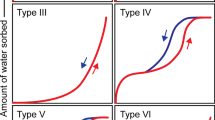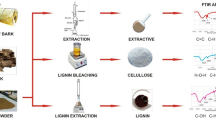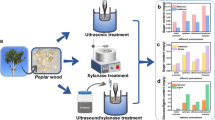Hevea brasiliensis
) esterified with acetic anhydride, maleic anhydride and phthalic anhydride was studied for moisture adsorption behaviour. FTIR spectroscopic technique was used to analyse the chemical changes in the wood through the correspondent reactions. Spectra indicated increasing intensity of the C=O and C-O stretching bands, and reduction in O-H stretching vibrations that reflects formation of less hygroscopic ester bonds with hydroxyl groups of cell wall polymers. Moisture adsorption isotherms show low equilibrium moisture content in esterified wood at all relative humidity values as compared to a control. The adsorption data was analysed by applying Hailwood-Horrobin theory which separated the adsorbed water into hydrated water and dissolved water corresponding to mono-layer and multi-layer adsorption. Curve for Mh and Ms were similar in pattern for esterified wood and control with different magnitude. Low Mh and Ms in esterified wood indicate reduction in moisture adsorption sites. Inaccessible fraction of wood for water vapour was increased by 43%, 32% and 26% in acetic, maleic and phthalic anhydride treated wood, respectively, compared to the control. Acetic anhydride treatment was found most effective in reducing hygroscopicity of wood.
Hevea brasiliensis
) wurde verestert mit Anhydriden der Maleinsäure, Essigsäure und Phtalsäure. Das Adsorptionsverhalten bei verschiedenen Feuchten wurde mit FTIR-Methoden untersucht, um die entsprechenden chemischen Abläufe zu erfassen. Intensivere C=O, und -C-O- Streckschwingungen sowie reduzierte OH-Schwingungen reflektieren die neu gebildeten, weniger hygroskopischen Esterbindungen. Bei allen modifizierten Proben ergaben sich niedrigere Gleichgewichtsfeuchten. Die Adsorptions-Isothermen wurden mit Hilfe der Hailwood-Horrobin Theorie analysiert, um adsorbiertes (Mh) und gelöstes (Ms) Wasser zu unterscheiden. Der Kurvenverlauf für Mh und Ms für modifiziertes und unbehandeltes Holz war qualitativ ähnlich, und unterschied sich nur quantitativ. Geringe Werte für Mh und Ms zeigen eine Verringerung der möglichen Adsorptionsstellen an. Der nicht zugängliche Anteil des Holzes, bezogen auf Kontrollproben, verringerte sich auf 43% (Acetanhydrid), 32% (Maleinsäureanhydrid) und 26% (Phthalsäureanhydrid). Acetanhydrid erwies sich als das effektivste Mittel, um die Hygroskopizität zu erniedrigen.
Similar content being viewed by others
Author information
Authors and Affiliations
Rights and permissions
About this article
Cite this article
Chauhan, S., Aggarwal, P., Karmarkar, A. et al. Moisture adsorption behaviour of esterified rubber wood (Hevea brasiliensis). Holz als Roh- und Werkstoff 59, 250–253 (2001). https://doi.org/10.1007/s001070000152
Issue Date:
DOI: https://doi.org/10.1007/s001070000152




